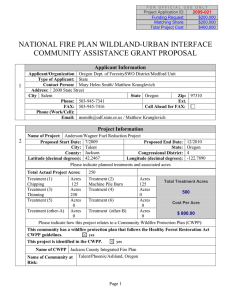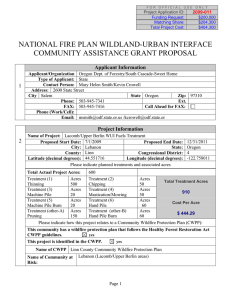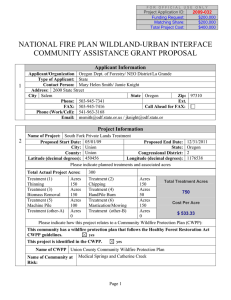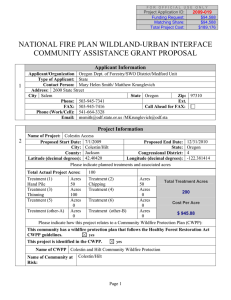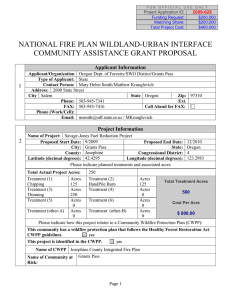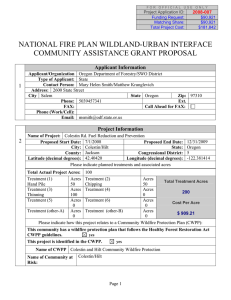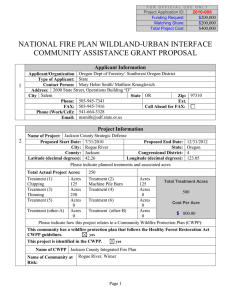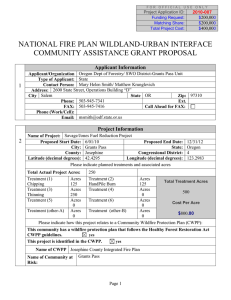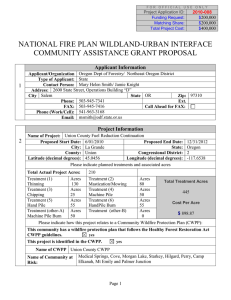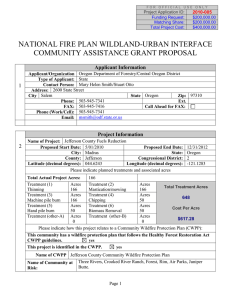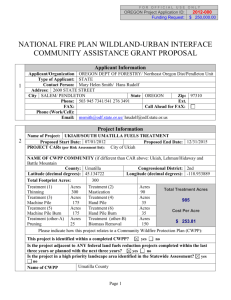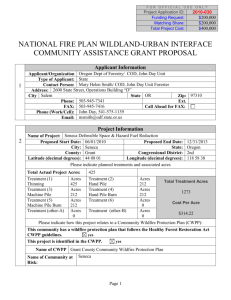NATIONAL FIRE PLAN WILDLAND-URBAN INTERFACE COMMUNITY ASSISTANCE GRANT PROPOSAL 1
advertisement
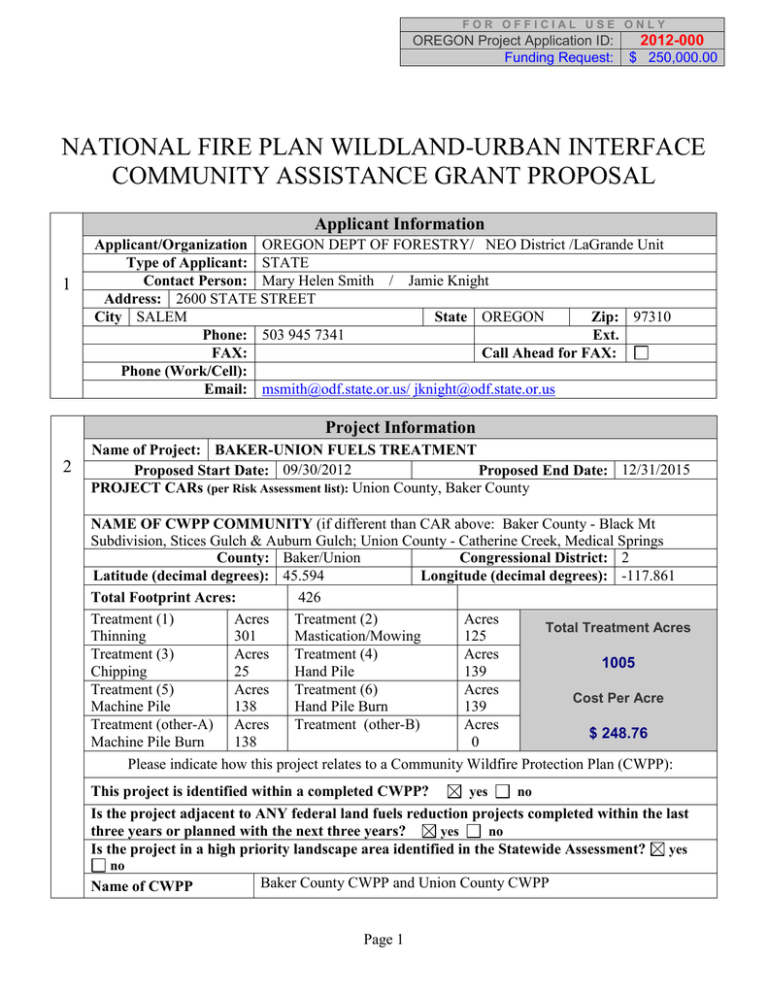
FOR OFFICIAL USE ONLY OREGON Project Application ID: Funding Request: 2012-000 $ 250,000.00 NATIONAL FIRE PLAN WILDLAND-URBAN INTERFACE COMMUNITY ASSISTANCE GRANT PROPOSAL Applicant Information 1 Applicant/Organization OREGON DEPT OF FORESTRY/ NEO District /LaGrande Unit Type of Applicant:: STATE Contact Person: Mary Helen Smith / Jamie Knight Address: 2600 STATE STREET City SALEM State OREGON Zip: 97310 : : Phone: 503 945 7341 Ext. FAX: Call Ahead for FAX: Phone (Work/Cell): Email: msmith@odf.state.or.us/ jknight@odf.state.or.us Project Information 2 Name of Project: BAKER-UNION FUELS TREATMENT Proposed Start Date: 09/30/2012 Proposed End Date: 12/31/2015 PROJECT CARs (per Risk Assessment list): Union County, Baker County NAME OF CWPP COMMUNITY (if different than CAR above: Baker County - Black Mt Subdivision, Stices Gulch & Auburn Gulch; Union County - Catherine Creek, Medical Springs County: Baker/Union Congressional District: 2 Latitude (decimal degrees): 45.594 Longitude (decimal degrees): -117.861 426 Total Footprint Acres: Treatment (1) Acres Treatment (2) Acres Total Treatment Acres ca Thinning 301 Mastication/Mowing 125 Treatment (3) Acres Treatment (4) Acres 1005 Chipping 25 Hand Pile 139 Treatment (5) Acres Treatment (6) Acres Cost Per Acre Machine Pile 138 Hand Pile Burn 139 Treatment (other-A) Acres Treatment (other-B) Acres $ 248.76 Machine Pile Burn 138 0 Please indicate how this project relates to a Community Wildfire Protection Plan (CWPP): This project is identified within a completed CWPP? yes no Is the project adjacent to ANY federal land fuels reduction projects completed within the last three years or planned with the next three years? yes no Is the project in a high priority landscape area identified in the Statewide Assessment? yes no Name of CWPP Baker County CWPP and Union County CWPP Page 1 Project Area Description All information for the project must fit into the space provided below. Attachments will not be considered by the review committee. 3 Provide a brief overview of the project and the project area. (If applying for a fuels reduction project, identify vegetation types, fire regime) [1500 Characters Maximum] Proposal is for combined fuel reduction (426 acres) in Baker & Union Counties to mitigate hazardous fuel loads within the WUI areas of Black Mt., Stices Gulch, Auburn Gulch located in Baker County, along with the Catherine Creek & Medical Springs WUI’s in Union County. These are considered high risk communities per the 2006 Oregon Statewide Risk Assessment/ 2010 Statewide Forest Resource Assessment Strategy. Vegetation types consist predominantly of mixed conifer stands with heavy brush & overstocked conifers in the understory. Juniper eradication will be a component of the Auburn project area, where it has encroached on the targeted mixed conifer stands. As a result of past & current fire suppression efforts & lack of active management, many stands are Fire Regime Condition Class 2 or 3. The primary goal of this project is to shift these stands towards a desirable lower risk or a FRCC Condition Class 1 rating. Proposed project boundaries are all adjacent to recent past, present or future Wallow Whitman National Forest fuels treatment projects such as: the Sundry/Rooster Rock, Little Dean, Wilson, Stices Interface (Baker County) Medical Springs & South Fork (Union County). Nine (60 acres) NRCS EQIP Forestry projects are contracted to begin on private forestland in 2012, many of which are located in our proposed project areas & would dovetail with this grant. Oregon Watershed Enhancement Board (OWEB) funds are being used to treat additional acres within the ODF District boundary. The goal is to maximize fuel reduction benefits to all landowners & provide larger scale community fuel breaks across the landscape for maximum protection benefits to the identified CARs. Project Timeline All information for the project must fit into the space provided below. Attachments will not be considered by the review committee. 4 Provide a timeline for the project. [500 Characters Maximum] *September 2012-December 2013—Contact landowner, conduct assessments, provide prevention education and cost-share agreements *December 2013-June 2015—Monitor and inspect landowner projects and continue to engage additional landowners in enrolling under cost share agreement for project activities. *September 2013-December 2015—Complete project inspections and approve final landowner payments, report accomplishments. Prepare final reports. Page 2 Scope of Work All information for the project must fit into the space provided below. Attachments will not be considered by the review committee. 5 Provide a brief scope of work which clearly describes how grant funds will be spent. (This should be more specific than the project description) [1500 Characters Maximum] This landowner cost share project is for thinning overstocked stands; treat/remove slash generated from the thinning; as well as treat/remove pre-existing ladder fuels & dead/down material (426 acres). Funds will be used: *primarily (70%) for cost share payments to landowners; *ODF forester wages (14%) to provide field/fiscal administration; provide risk assessments & unique site fuel treatment specifications for each project; entering into cost share agreement with landowners; one-on-one landowner prevention education; inspection of project sites to assure specifications have been met & authorization of cost share payment; * 1% will also be used under an agreement between ODF & Baker County Fire Prevention Coop to carry out public prevention education & outreach to landowners using the Living with Fire brochure and/or Firewise Communities USA literature; &, * 14% for vehicle use for forester travel to/from project sites, postage/ brochures/ supplies for prevention education & indirect costs. ODF will prioritize project sites based on: (1) highest understory stocking density; (2) private land projects directly adjacent to the USFS fuel projects; &, (3) adjacency to other fuel projects on private land. In significant juniper encroachment areas, juniper eradication (sparing only old growth decadent juniper trees) coupled with an effective slash treatment will best protect the communities. These practices will help meet the goal of moving the forestland in these WUI’s back towards a Condition Class 1. Biomass utilization will be encouraged on all projects where it is economically practical & markets exist, including the Warm Hearts Warm Hands program. Interagency Collaboration All information for the project must fit into the space provided below. Attachments will not be considered by the review committee. 6 Specify the private, local, tribal, county, state, federal and/or non-governmental [501(c)(3)] organizations that will contribute to or participate in the completion of this project. Describe briefly the contributions each partner will make (i.e. – donating time/equipment, funding, etc.) [500 Characters Maximum] *Landowners will enroll under cost share agreements & perform or pay a portion of project costs *ODF, Forest Service, BLM, OR Dept of Fish & Wildlife, NRCS, FSA, OSU extension, Rural Fire Depts: will advertise project availability, provide prevention education *Baker CO Fire Prevention Coop will advertise cost-share opportunities, provide educational assistance & increase public awareness of benefits of fuel reduction, & provide technical advice to landowners *ODF will coordinate with other fuel reduction projects in the area (i.e., NRCS, OR Watershed Enhancement Board) Page 3 Project Longevity / Maintenance All information for the project must fit into the space provided below. Attachments will not be considered by the review committee. 7 Clearly describe how the proposed treatments will be maintained over time. [500 Characters Maximum] Landowners will sign a 10-year maintenance agreement. ODF will conduct spot checks to ensure maintenance requirements are met. Mailings will be sent at 3 year intervals to remind landowners of their obligation to maintain the project & offer technical them assistance. Fuel reduction projects will reduce stocking levels to a density which will remain viable over the time that the average tree will grow to become economically viable as commercial thinning. Project will create fuel conditions that ensure fires stay on the ground under most burning conditions for at least 10 years. Biomass Utilization All information for the project must fit into the space provided below. Attachments will not be considered by the review committee. For the purpose of this application, biomass utilization is defined as any practicable end-use of the material that has value, or the trading of capital for the woody material. 8 Biomass from treatment(s) will be utilized. (check one) yes no except as noted below 1) If yes, how is it planned to be used, or what is the end-result (wood products, steam/energy, mulch etc.) [500 Characters Maximum] Whenever practical and cost-effective, landowners will be encouraged to have biomass material removed from the project area and transported to processing facilities for use as post and pole, pulp wood, chips and hog fuel for steam energy, and firewood, and other fledgling biomass opportunities that are locally emerging. In Union County, the Warm Hearts Warm Homes program collects, processes, and distributes wood to low-income and elderly citizens that would otherwise be unable to collect the fuel needed for the winter months. FACTS REPORTING Please identify your local US Forest Service staff person who is responsible to enter data into the US Forest Service FACTS reporting system. Name: Kat Naughton Phone Number: (541)962-8563 Page 4 Project Budget Cost Category Description Federal Agency Personnel $26,000.00 $0.00 $26,000.00 $0.00 $0.00 $0.00 $0.00 $0.00 $0.00 $0.00 $0.00 $0.00 $26,000.00 $0.00 $26,000.00 $8,840.00 $0.00 $8,840.00 $0.00 $0.00 $0.00 $0.00 $0.00 $0.00 $0.00 $0.00 $0.00 $8,840.00 $0.00 $8,840.00 Subtotal $3,600.00 $0.00 $3,600.00 $0.00 $0.00 $0.00 $0.00 $0.00 $0.00 $0.00 $0.00 $0.00 $3,600.00 $0.00 $3,600.00 Subtotal $0.00 $0.00 $0.00 $0.00 $0.00 $0.00 $0.00 $0.00 $0.00 $0.00 $0.00 $0.00 $0.00 $0.00 $0.00 Subtotal $1,000.00 $0.00 $1,000.00 $0.00 $0.00 $0.00 $0.00 $0.00 $0.00 $0.00 $0.00 $0.00 $1,000.00 $0.00 $1,000.00 Cost-Share Agreements Baker County Fire Prev. Coop. Subtotal $175,320.00 $3,000.00 $178,320.00 $0.00 $0.00 $0.00 $0.00 $0.00 $0.00 $0.00 $0.00 $0.00 $175,320.00 $3,000.00 $178,320.00 $32,240.00 $0.00 $32,240.00 $0.00 $0.00 $0.00 $0.00 $0.00 $0.00 $0.00 $0.00 $0.00 $32,240.00 $0.00 $32,240.00 $250,000.00 $0.00 $0.00 $0.00 $250,000.00 NRS1/NRS2 Subtotal Fringe Benefits OPE For Field Staff Subtotal Travel Forester Travel To/From Project Equipment Supplies Postage, brochures, supplies Contractual Other INDIRECT Subtotal Total Costs Project (Program) Income1 1 Program income is the gross revenue generated by a grant or cooperative agreement supported activity during the life of the grant. Program income can be made by recipients from fees charged for conference or workshop attendance, from rental fees earned from renting out real property or equipment acquired with grant or cooperative agreement funds, or from the sale of commodities or items developed under the grant or cooperative agreement. The use of Program Income during the project period will require prior approval by the granting agency.
